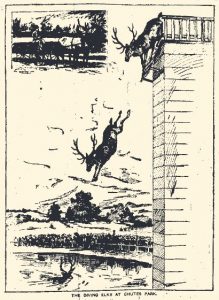The history of Denver’s entertainments and amusements is a colorful one. From diving elks to advertising elephants, Denver’s amusements went well beyond sports, music, and theater.
A history of Denver’s Lakeside Amusement Park is one of the newest additions to our collection. David Forsyth’s Lakeside Amusement Park: From the White City Beautiful to a Century of Fun, published by University Press of Colorado, tells the story of this long-surviving Northwest Denver venue. Forsyth has also written several articles on Denver’s amusement park history for Colorado Heritage magazine, which is available from our library. Articles include histories of Celebrity Sports Center, a favorite memory of Gen-X-ers (Autumn 2007), and Arlington Park (May-June 2015).
 |
| A Rocky Mountain News illustration of the Diving Elks. |
Arlington Park is one of my favorite Denver amusement park stories. Built where Alamo Placita Park is today, it was developed in the early 1890s and owned by a partnership which included none other than Denver’s famous (or infamous) Mayor Speer. Speer and his partners had an artificial lake constructed on the site, and this became the central feature of the new amusement park, which, unlike the placid Elitch’s, banked on sensationalism. They staged a huge “Last Days of Pompeii” reenactment with impressive pyrotechnics, and offered acrobats, vaudeville, a “lady lion tamer,” and the 617-pound “Monster Man from Switzerland.” At the lake was a “Shoot the Chutes” water slide, which led to the park’s name change to Chutes Park in 1897. One of the favorite attractions was Professor Barnes’ Diving Elks, who were trained to dive into the lake from a 50-foot tower! After a series of fires and other mishaps, Arlington/Chutes Park closed for good in 1903. The lake was filled in, the land sold for residential lots, and Denver’s most sensational amusement park was nearly forgotten.
Other amusement parks such as Elitch’s are gone but not forgotten. The original Elitch’s on 38th and Tennyson entertained generations of Denverites from 1890 to 1995, when it closed and a new park was built in the Platte Valley using the Elitch’s name. The story of Elitch’s can be found in Rediscovering Northwest Denver: Its History, Its People, Its Landmarks by Ruth Wiberg, published by the University Press of Colorado and available for checkout from our library.
Circuses were another important part of Denver’s entertainment history. In fact, the Barnum neighborhood is so named because P.T. Barnum purchased land there in 1878, allegedly as a winter home for his circus, but that never materialized. Denver’s most colorful circus, however, was the Sells-Floto, owned by Denver Post publishers Harry Tammen and Fred Bonfils in the 1910s and twenties. They used the circus — and its animals — to promote the paper. Tammen was especially fond of the elephants; you can read the story of one of them in Dick Kreck’s article “The Day Little Miracle Died,” found in the Summer 1998 issue of Colorado Heritage.
Denver has had many other well-known entertainments and amusements through the years. Check out Colorado Heritage and its predecessor Colorado Magazine for more stories on Denver’s favorite pastimes, including the Denver Broncos (Nov/Dec 2012, Winter 1997), theaters (various issues), museums (various issues), the Denver Performing Arts Complex (Summer 2007), brewpubs (Winter 2000), baseball (Winter 2000, Spring 1995), opera (Spring 1999), symphony orchestras (Autumn 1992), bicycling (spring 1991, November 1933), nickelodeons (issue 3, 1984), saloons (Spring 1975), Denver Mountain Parks (January 1932), and more.
- How to Spot the Differences Between Eagles and Hawks - August 16, 2021
- How Transportation Projects Help Tell the Story of Colorado’s Past - August 9, 2021
- Time Machine Tuesday: The Night the Castlewood Canyon Dam Gave Way - August 3, 2021
